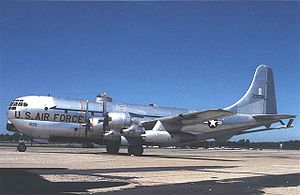Boeing KC-97
| KC-97 Stratofreighter | |
|---|---|
 |
|
| KC-97L in Ohio Air National Guard markings | |
| Role | Strategic tanker |
| Manufacturer | Boeing |
| Introduction | July 14, 1951 |
| Retired | June 1978 |
| Primary users |
United States Air Force Spanish Air Force |
| Produced | 1951–1956 |
| Number built | 811 |
| Developed from | Boeing C-97 Stratofreighter |
The Boeing KC-97 Stratofreighter is a United States strategic tanker aircraft based on the Boeing C-97 Stratofreighter. It was succeeded by the Boeing KC-135 Stratotanker.
The KC-97 Stratofreighter was an aerial refueling tanker variant of the C-97 Stratofreighter (which was itself based on the Boeing B-29 Superfortress), greatly modified with all the necessary tanks, plumbing, and a flying boom. The cavernous upper deck was capable of accommodating oversize cargo accessed through a very large right-side door. In addition, transferrable jet fuel was contained in tanks on the lower deck (G-L models). Both decks were heated and pressurized for high altitude operations.
Note: Occasionally the KC-97 has been quoted as "Stratotanker". However, all reputable sources refer to the KC-97 as Stratofreighter, not -tanker. This includes both Boeing and the USAF themselves.
The USAF began operating the KC-97 in 1950. It purchased a total of 811 KC-97s from Boeing, as opposed to only 74 of the C-97 cargo version. The KC-97 carried aviation gasoline for its own piston engines but it carried jet fuel for its refueling mission, this required an independent system for each type of fuel. However, it was able to offload its aviation gas to a receiver in an emergency in a procedure known as a "SAVE".
These tankers were vitally important to the world-wide Boeing B-47 Stratojet strategic operations. An example was the support of Arctic reconnaissance flights from Thule Air Base.
While it was an effective tanker, the KC-97's slow speed and low operational altitude complicated refueling operations with jet aircraft. B-52s typically lowered their flaps and rear landing gear to slow the aircraft enough to refuel from the KC-97. In addition, a typical B-52 refueling engagement profile would involve a descent that allowed the aircraft pair to maintain a higher airspeed (220-240 knots). In the early 1960s, the Tactical Air Command added General Electric J47 jet pods from retired KB-50 tankers to produce the KC-97L. The jet pods increased performance and made the KC-97 more compatible with jet aircraft.
...
Wikipedia
